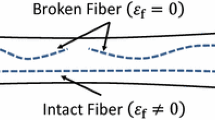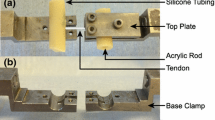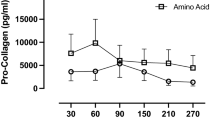Abstract
Passive elastic behavior of tendon tissue from rats subjected to different dietary treatments was characterized. For that purpose, twenty-four weanling Wistar rats (41.02 ± 0.16 g) were randomly distributed into four groups. During 88 days each group was fed on different diets: control diet and diets containing advanced glycation end products (AGEs) from glucose–lysine model system, from bread crust and bread dough, respectively. After the trial animals were sacrificed and tendon samples were extracted and tested mechanically to fracture in a uniaxial tensile test machine. A transversely-hyperelastic model was formulated based on stress–strain relationships and its parameters were fit to the experimental data using the Levenberg–Marquardt optimization algorithm. Material parameters were incorporated in a finite element model to study different stress–strain distributions in a muscle-tendon unit. Results show higher strains and stresses in the muscle belly when properties of a stiffer tendon associated with a diet rich in AGEs are included in the model. A real increase in this mechanical response of the tissue could imply possible pain in joint mobility.







Similar content being viewed by others
References
Adams, M. A. Biomechanics of back pain. Acupunct. Med. 22(4):178–188, 2004.
Alikhani, M., Z. Alikhani, C. Boyd, C. M. MacLellan, M. Raptis, R. Liu, N. Pischon, P. C. Trackman, L. Gerstenfeld, and D. T. Graves. Advanced glycation end products stimulate osteoblast apoptosis via the map kinase and cytosolic apoptotic pathways. Bone 40(2):345–353, 2007.
Bailey, A. J., R. G. Paul, and L. Knott. Mechanisms of maturation and ageing of collagen. Mech. Ageing Dev. 106(1-2):1–56, 1998
Baynes, J. W. The maillard hypothesis on aging: time to focus on dna. Ann. N. Y. Acad. Sci. 959:360–367, 2002
Briefel, R. R., and C. L. Johnson. Secular trends in dietary intake in the united states. Annu. Rev. Nutr. 24:401–431, 2004.
Brownlee, M. Advanced protein glycosylation in diabetes and aging. Annu. Rev. Med. 46:223–234, 1995.
Buehler, M. J. Nature designs tough collagen: explaining the nanostructure of collagen fibrils. Proc. Natl Acad. Sci. USA 103(33):12285–12290, 2006.
Calvo, B., A. Ramírez, A. Alonso, J. Grasa, F. Soteras, R. Osta, M. J. Muñoz. Passive nonlinear elastic behaviour of skeletal muscle: experimental results and model formulation. J. Biomech. 43(2):318–325, 2010.
Delgado-Andrade, C., J. A. Rufián-Henares, R. Nieto, J. F. Aguilera, M. P. Navarro, I. Seiquer. Does the pelleting process affect the nutritive value of a pre-starter diet for suckling piglets? Ex vivo studies on mineral absorption. J. Agric. Food Chem. 90(5):898–905, 2010.
Delgado-Andrade, C., I. Seiquer, and M. P. Navarro. Comparative effects of glucose–lysine versus glucose–methionine maillard reaction products consumption: in vitro and in vivo calcium availability. Mol. Nutr. Food Res. 49(7):679–684, 2005.
Delgado-Andrade, C., I. Seiquer, M. P. Navarro, F. J. Morales. Maillard reaction indicators in diets usually consumed by adolescent population. Mol. Nutr. Food Res. 51(3):341–351, 2007.
DeVita, P., and T. Hortobagyi. Age increases the skeletal versus muscular component of lower extremity stiffness during stepping down. J. Gerontol. A 55(12):B593–B600, 2000.
Finocchietti, S., M. Nielsen, C. D. March, L. Arendt-Nielsen, T. Graven-Nielsen. Pressure-induced muscle pain and tissue biomechanics: a computational and experimental study. Eur. J. Pain 15:36–44, 2011.
Geissler, S., M. Hellwig, M. Zwarg, F. Markwardt, T. Henle, and M. Brandsch. Transport of the advanced glycation end products alanylpyrraline and pyrralylalanine by the human proton-coupled peptide transporter hpepT1. J. Agric. Food Chem. 58(4):2543–2547, 2010.
Grasa, J., A. Ramírez, R. Osta, M. J. Muñoz, F. Soteras, and B. Calvo. A 3D active-passive numerical skeletal muscle model incorporating initial tissue strains. Validation with experimental results on rat tibialis anterior muscle. Biomech. Model. Mechanobiol. 10(5):779–787, 2011.
Holzapfel, G. A. Nonlinear Solid Mechanics. New York: Wiley, 2000.
Holzapfel, G. A., G. Sommer, C. T. Gasser, and P. Regitnig. Determination of layer-specific mechanical properties of human coronary arteries with nonatherosclerotic intimal thickening and related constitutive modeling. Am. J. Physiol. Heart Circ. Physiol. 289(5):H2048–H2058, 2005.
Isaksson, H., T. Harjula, A. Koistinen, J. Livarinen, K. Seppänen, J. P. A. Arokoski, P. A. Brama, J. S. Jurvelin, and H. J. Helminen. Collagen and mineral deposition in rabbit cortical bone during maturation and growth: effects on tissue properties. J. Orthop. Res. 28(12):1626–1633, 2010.
Khalsa, P. S., and W. Ge. Encoding of tensile stress and strain during stretch by muscle mechano-nociceptors. Muscle Nerve 30(2):216–224, 2004.
MacIntosh, B. R., P. F. Gardiner, and A. J. McComas. Skeletal Muscle Form and Function, 2nd ed. Champaign, IL: Human Kinetics, 2006.
Ogden, R. W. Nonlinear elasticity, anisotropy, material stability and residual stresses in soft tissue. lecture notes. CISM Course on Biomechanics of Soft Tissue, Udine, 2001.
Olabisi, R. M., T. M. Best, C. Hurschler, R. Vanderby, and K. J. Noonan. The biomechanical effects of limb lengthening and botulinum toxin type a on rabbit tendon. J. Biomech. 43(16):3177–3182, 2010.
Reddy, G. K. Cross-linking in collagen by nonenzymatic glycation increases the matrix stiffness in rabbit achilles tendon. Exp. Diabesity Res. 5(2):143–153, 2004.
Reeves, P. G., F. H. Nielsen, and G. C. Fahey. AIN-93 purified diets for laboratory rodents: final report of the American Institute of Nutrition ad hoc writing committee on the reformulation of the AIN-76A rodent diet. J. Nutr. 123(11):1939–1951, 1993.
Saito, M., and K. Marumo. Collagen cross-links as a determinant of bone quality: a possible explanation for bone fragility in aging, osteoporosis, and diabetes mellitus. Osteoporos Int. 21(2):195–214, 2010.
Saudek, D. M., and J. Kay. Advanced glycation endproducts and osteoarthritis. Curr. Rheumatol. Rep. 5(1):33–40, 2003.
Shinabarger, N. I. Limited joint mobility in adults with diabetes mellitus. Phys. Ther. 67(2):215–218, 1987.
Spencer, A. J. M. Continuum Physics. Theory of Invariants. New York: Academic Press, 1954
Tessier, F. J., C. Niquet, L. Rhazi, K. Hedhili, M. P. Navarro, I. Seiquer, and C. Delgado-Andrade. The Maillard Reaction. Interface Between Aging, Nutrition and Metabolism, chap. Ne-Carboxymethyllysine: Its Origin in Selected Foods and Its Urinary and Faecal Excretion in Healthy Humans. Cambridge: Royal Society, 2010, pp. 144–150.
Verzijl, N., J. DeGroot, Z. C. Ben, O. Brau-Benjamin, A. Maroudas, R. A. Bank, J. Mizrahi, C. G. Schalkwijk, S. R. Thorpe, J. W. Baynes, J. W. J. Bijlsma, F. P. J. G. Lafeber, and J. M. TeKoppele. Crosslinking by advanced glycation end products increases the stiffness of the collagen network in human articular cartilage: a possible mechanism through which age is a risk factor for osteoarthritis. Arthritis Rheum. 46(1):114–123, 2002.
Woo S. L.-Y and L. V. Tkach. Sports-Induced Inflammation: Clinical and Basic Concepts, Chapter: The cellular and matrix response of ligaments and tendons to mechanical injury. Park Ridge, Aaos Instr Cours Lec, 1990, pp. 189–213.
Acknowledgments
The authors gratefully acknowledge research support from the Spanish Ministry of Science and Technology through the research project DPI2011-27939-C02-01 as well as the financial support of the Junta de Andalucia. We also thank the Tissue Characterization Platform of CIBER-BBN for their technical support during development of the experimental tests.
Author information
Authors and Affiliations
Corresponding author
Additional information
Associate Editor Eiji Tanaka oversaw the review of this article.
Rights and permissions
About this article
Cite this article
Grasa, J., Calvo, B., Delgado-Andrade, C. et al. Variations in Tendon Stiffness Due to Diets with Different Glycotoxins Affect Mechanical Properties in the Muscle-Tendon Unit. Ann Biomed Eng 41, 488–496 (2013). https://doi.org/10.1007/s10439-012-0674-5
Received:
Accepted:
Published:
Issue Date:
DOI: https://doi.org/10.1007/s10439-012-0674-5




